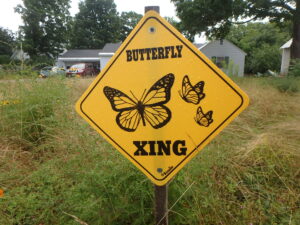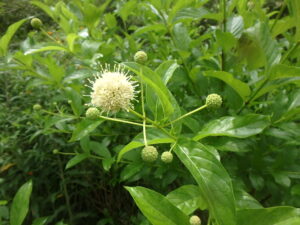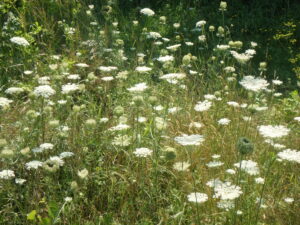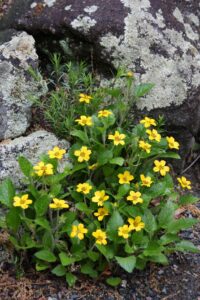Re-Wilding Your Lawn
Posted on Tuesday, August 18, 2020 · Leave a Comment

A sign like this lets neighbors know you are not lazy, but letting the lawn grow for a reason
Tired of mowing your lawn, but afraid to stop? What would it look like, and what would the neighbors say? I was on a panel discussing “re-wilding” the lawn on New Hampshire Public Radio recently. Here are a few of the points we discussed.
First, a lawn is the easiest, least time-consuming way to maintain your property. If you want a meadow of flowers for birds, bees and pollinators of all kinds, lots of work is involved. You can’t just quit mowing, or rototill the lawn and broadcast some wildflower seeds, and then step back to enjoy. You would get some nice flowers, but your yard would also fill up with weeds – and invasive trees.

Buttonbush flower
My advice? Start small. A little corner of the yard, say something 4 feet wide and 15 feet long would be a good start. Decide how much time you can commit to it, and how often you want to work in the garden. Can you dedicate half an hour each morning before work? An hour after work? Good gardens are built by people who do something in the garden every day.
Get a soil test done. New Hampshire and Rhode Island have stopped doing tests, Vermont will do them for Vermonters, and Maine, Massachusetts and Connecticut accept samples from out of state. Get a home gardener test with as much info as possible.
Next, you have to remove the grass. That means slicing through the lawn to create one-foot by one-foot squares that you can remove and take away to your (new?) compost pile. Don’t try to do it all at once, do a little at a time.
Do your homework. Read books and go on-line to see what will work in your yard. Do you have full sun (6 hours or more each day), part sun, or shade? Is your site hot and dry or cool and moist? Select flowers that will work in your climatic zone, and get a variety of bloom times: some for spring, others for early summer, late summer and fall.
Improve your soil. All soil can be improved with compost. Buy it by the truckload, not the bag. Get it delivered if you don’t have a truck. Work the compost into the soil after the grass is removed.

Queen Anne’s Lace is loved by bees and other pollinators
If you want to support butterflies, birds and bees, think native plants. Native plants are those that co-evolved with the wildlife. And let wildflowers be part of the mix. Right now Queen Anne’s lace is in bloom along the roadside. It’s a biennial in the carrot family and is loved by the bees. Learn to recognize the small first year plants, dig up a few and plant them. Once established, the flowers will drop seeds each year.
But what about the neighbors? One of the panelists had done a study in Springfield, MA. She asked homeowners to mow their lawn either weekly, every two weeks, or every three weeks. So that the neighbors would be more understanding, they put signs in the yards telling others that they were part of a scientific study.
They counted insects and found a two-week schedule for mowing was best for bees and pollinators: clover and dandelions had time to bloom, and to provide food without being hidden in tall grass.
To create a sustainable non-lawn, you need to introduce not only those tall, bright flowers like black-eyed Susans and purple coneflower, but groundcovers that will fill in between plants.
One of the panelists, Thomas Rainer, is the co-author with Claudia West of the book, “Planting in the Post-Wild World: Designing Plant Communities for Resilient Landscapes.” In their book they explain that in nature there are plant communities: plants that need roughly the same soil and light, and that co-exist nicely. If you want a balanced plant community, you need a diverse, supportive collection of plants, including groundcovers.

Chrysogonum virginianum is a nice groundcover
Groundcovers can act a bit like mulch: they can prevent soil erosion and suppress weeds. It is often tough to find good native groundcovers like groundsel (Packera obovata) or goldenstar ( Chrysogonum virginianum) for sale, but they are available if you look hard enough. Winecup (Callirhoe involucrata) is a good groundcover for hot dry, sunny places, and is often available. Oregano and thyme can be used as an understory groundcover that bees love, and they are readily available.
And Creeping Charlie (Glechoma hederacea)? It’s that “weed” hated by lawn-lovers because it can “spoil” a nice lawn and spread like crazy in part shade. But it is a native plant with nice flowers and is loved by bees. Think about letting it proliferate in your “non-lawn”.
Lastly, if you want a landscape that is beautiful and low maintenance, think about planting trees and shrubs. Many bloom nicely and all are useful to wildlife. Some native shrubs that I grow and love are fothergilla (Fothergilla major), blueberries, elderberry, buttonbush (Cephalanthus occidentalis) and our native rhododendron and azalea.
If you stop mowing the grass and want flowers, put up a sign. I recently saw one that was very simple: it said “Butterfly Crossing.” Hopefully that appeased the neighbors a little.
Henry is the author of 4 gardening books, and a frequent speaker at garden clubs and libraries, even now, using Zoom or at outdoor venues. Contact him at
henry.homeyer@comcast.net.






